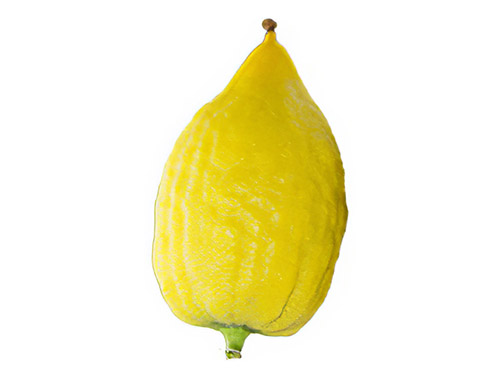
Sukkot may be the most difficult holiday for the average Jew and not for the obvious reason. Eating outdoors in huts during inclement weather certainly is no easy task but that is not the most challenging aspect of Sukkot. Far more onerous for your everyday Jew is having to walk around holding something edible (an etrog) and not being allowed to eat it. From a fresser’s perspective, that is cruel and unusual. Indeed, not eating may be toughest abstention imaginable for a Jew, rivaled only by not kibitzing and not kvetching.
For the record, an etrog is a piece of fruit that many find delicious, albeit after Sukkot. Some Jews turn the etrog into a tasty jam or marmalade. In fact, some consider etrog jam a segula (remedy) for easing the pains of childbirth. (Yes, this type of jam essentially is an etrog epidural.) Others transform the etrog into a succade (candied peel). The term “succade,” at least according to some experts, derives from the term “sukkah” and directly relates to the etrog’s prominence on the holiday. (No, “Rosh Hashanade” is not a term for a candied apple.) Some use the etrog to make a liqueur or beer including ‘Trog Wit Beer manufactured by the Tel Aviv-based “The Dancing Camel Brewery.” That said, you are unlikely to find etrogim at your local falafel stand, burger bar or smoothie shop and etrog-flavored rugelach would be the rarest of rugelach.
Even though the etrog can be transformed into delectable treats, most Jews do not often think of the etrog as edible because they are too busy protecting it from harm’s way. It is a quite a precarious task since the helpless etrog features a freakishly fragile pitom (tip) that must remain intact. The pitom is even more fragile than the confidence of a (i) pitcher who gives up twenty home-runs in the first inning, (ii) young Jewish single who is on his/her twentieth shadchan and (iii) child who has suffered twenty years of unproductive parental comments like “Why can’t you be more like your cousin, the doctor who is president of the school and shul and yet still finds time to call us once a week to ask how we are doing?”
Due to the etrog’s fragility, Jews go to great lengths to protect it. They wrap the etrog in silky flax fibers or similar materials, or place them in foam, within a cardboard box or metal container. Imagine Jews treating other edible items in this fashion. What if, on Chanukah, you had to keep your sufganiyot in a protective case to prevent any outer-crust crumbling? What if, on Purim, you had to individually wrap your Hamantaschen to avoid any possible disintegration? What if, on Passover, you had to shield every piece of matzah from even the slightest break?
Sukkot is even harder when you consider that Jews have to parade the etrog around a crowded and hectic shul, which is just asking for trouble. It would be like the Secret Service openly marching the President of the United States through a mosh pit of unpatriotic unfriendlies. In addition, the shaking of the etrog, along with the lulav, is rather unique because Jews do not normally shake their food. Shaking a bowl of cholent would create quite a mess, shaking a bowl of matzah ball soup might lead to first-degree burns and shaking a bowl of borscht should never be done while wearing white. (So, for you fashionistas out there, only shake a bowl of borscht after Labor Day.)
The Talmud has plenty to say about the etrog. For example, Sukkah 36(a) provides: “An etrog that is… pickled, boiled, a black Cushite etrog, a white etrog, or a speckled etrog is unfit.” A pickled speckled etrog sounds as appetizing as a chopped liver lollipops.
Sukkah 36(a) further states that “[a]n etrog shaped like a ball is unfit, and some say even a twin, conjoined, etrog is unfit.” A Siamese etrog may not be fit for Sukkot-purposes but it would make quite a fragrant pomander ball.
The Talmud adds that if a person grew an etrog “in a mold and shaped it to appear like a different entity, and it is no longer shaped like an etrog, it is unfit.” Other things in life also depend on shape. For example, a wheel must be circular, a football must be prolate spheroidal, hamantaschen must be triangular and a dunce cap must be conical.
Final thought: What were the etrog farmer’s final words upon learning that his loyal employee had betrayed him? Answer: “Et-Rog, Brute?”
By Jon Kranz













